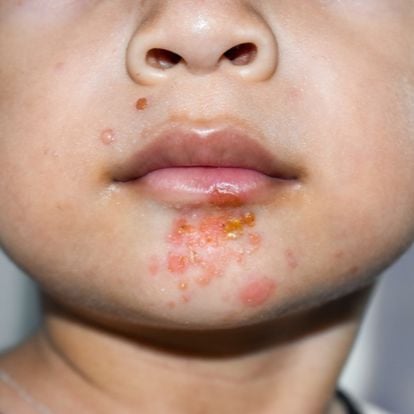 OVERVIEW
OVERVIEW
Impetigo is a common, highly contagious, skin infection. It is caused by a bacteria, usually either Streptococcus pyogenes or Staphylococcus aureus, which enters the skin through a minor cut or scrape causing a local infection in the skin.
What are the Symptoms of Impetigo?
There are two classic forms of impetigo: non-bullous impetigo and bullous impetigo.
Non-bullous impetigo is more common than bullous impetigo. It is commonly found on the face or the extremities, though it can affect any part of the body. Typically, the infection starts as a red, itchy bump that breaks open and drains clear fluid or pus. The drainage then dries to form a yellow or honey-colored crust overlying the sore. Lesions can be itchy or painful. Lymph nodes in the affected areas may be enlarged. The infection is easily spread from one area to another, often causing kissing lesions (lesions that form where two skin surfaces touch) or satellite lesions (new sites of infection nearby or closeby to the initial site of infection).
Bullous impetigo is less common than non-bullous impetigo. In addition to affecting the face and extremities, the diaper region is another common location for bullous impetigo. The infection presents as fluid filled blisters that contain purulent or yellowish fluid. The blisters easily break open forming a sore. Yellow or honey-colored crusts can form at the edge of a popped blister. Fever and enlarged lymph nodes can be seen in association with impetigo.
Who is at Risk and How Does it Spread?
Impetigo is highly contagious and can easily spread from one part of the body to another (auto-inoculation) or from one person to another. It can spread through direct skin-to-skin contact or from contact with a contaminated item such as bedding, towels, toys, or sports equipment.
Although impetigo can affect anyone, some factors increase our risk including:
- Age: Although seen in all age groups, the disease is most common in infants and young children.
- Breaks to Our Skin: Bug bites, pre-existing rashes (such as eczema), and injuries (cuts or scratches) all create small breaks in our skin which provides an entry point for the bacteria to invade our skin and cause infection.
- Close contact or crowding: Because the condition is highly contagious, it can be easily spread to other people living in the same household. It is also easily spread in crowded conditions such as schools and daycare facilities.
- Climate: Impetigo is more common in warm, humid climates.
- Poor hygiene: Lack of proper hand washing and bathing can increase a person’s risk of getting impetigo.
How is Impetigo Diagnosed?
A dermatologist is often able to diagnose impetigo by examining the affected areas. A culture may be obtained at the visit to determine what type of bacteria is causing the infection and which antibiotics may work best. A culture is obtained by swabbing the sore with a cotton tip applicator and sending it to a laboratory for evaluation.
Treatment for Impetigo
Antibiotics are effective at treating impetigo. Topical antibiotics are commonly used for mild, localized disease. For more severe or widespread infections, your dermatologist may prescribe an oral antibiotic. Because of the highly contagious nature of the disease, children should be kept home from daycare and school and wrestlers should not participate in matches until they have been adequately treated with antibiotics.
 OVERVIEW
OVERVIEW
